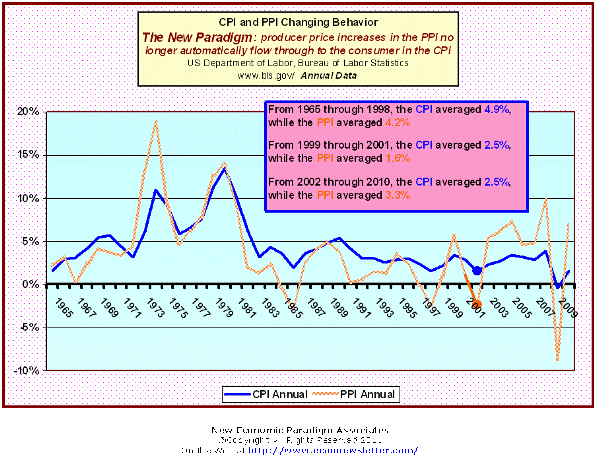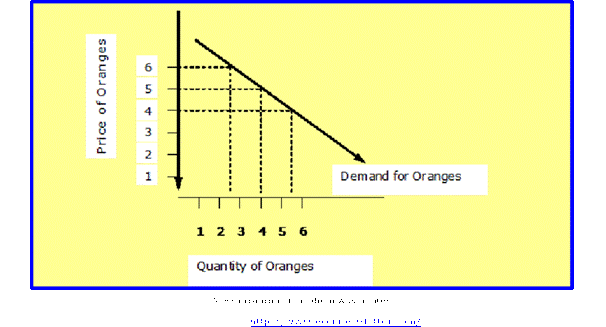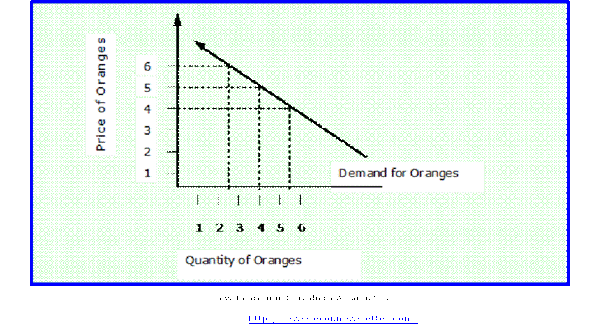February 12, 2011
For a downloadable version, click the following:
INFLATION BY DECONTENTING
Less roll for your buck?
The case of the shrinking toilet tissue roll: 4.51 inches – down to 4.1 inches
Several years ago, this Newsletter examined inflation data that showed retailers were having trouble passing on rising costs incurred at the wholesale level. The traditional pattern of the Producer Price Index (PPI) and the Consumer Price Index (CPI) had reflected a lagged reaction of the CPI to the PPI, with the CPI lagging the PPI by a few months and coming in higher than the PPI due to what most argued was the inclusion of the more inflation prone retail services in the CPI that were at best only remotely related to the elements of the PPI.

We at the New Economic Paradigm Associates in our Newsletters and blogs and in presentations and conferences, argued the change in this pattern was due to increasing competition, especially at the retail level. Lack of competition leads to downward price rigidity and introduces into the macroeconomy twin biases toward inflation and recession. As the product (goods and services) and productive resource markets (such as labor and financial) become more competitive, prices become more flexible downward as firms lose market and price power. This slowly reduces the twin biases of recession and inflation that lack of competition had introduced into the economy’s markets.
In the labor markets as well, unionized labor has been on a steady decline in the private sector.
U.S. Department of Labor
Bureau of Labor Statistics
January 21, 2011
Union Membership (Annual)
www.bls.gov/news.release/union2.pdf
In 2010, the union membership rate—the percent of wage and salary workers who were members of a union—was 11.9 percent, down from 12.3 percent a year earlier, the U.S. Bureau of Labor Statistics reported today. The number of wage and salary workers belonging to unions declined by 612,000 to 14.7 million. In 1983, the first year for which comparable union data are available, the union membership rate was 20.1 percent, and there were 17.7 million union workers.
As we pointed out in earlier newsletters and blogs, there have been exceptions, such as the re-cartelization of the U.S. segment of the oil industry from 1993-2003 and the increased unionization (cartelization) of state and local government employees.
Cartelistic v. Competitive Free Market Capitalism
May 13, 2008
Two Current Cases: Oil v. Autos
www.econnewsletter.com/may132008
The inability to pass on rising costs at the wholesale level to customers at the retail level because of increasing competition is good for the consumers as it forces retail firms to be more efficient and pressures them toward the achievement of what are called the theoretical economic welfare conditions of equity and efficiency. In previous newsletters and blogs, these conditions were thoroughly explained but for convenience to the reader they will be briefly restated here.
- Efficiency
- is the condition that when achieved in the economy, the average or per capita material standard of living is maximized given the state of technology, stock of productive resources, etc. Technically, it is achieved when for individual firms, the price of their products is just equal to the firm’s marginal opportunity costs and the individual firm’s average opportunity costs are at a minimum.
- Equity
- is the condition that when achieved, the consumer surplus is maximized subject to the constraint that all productive resources (labor, debt and equity capital, entrepreneurship, and land as conventionally defined) earn their opportunity costs, no more or no less.
These theoretical economic welfare conditions are only achieved when the markets are perfectly competitive - but as competition in markets increases, the markets do move closer to the achievement of these conditions.
The Importance of the Limiting Case; i.e., Perfect Competition
The end game of a universe expanding at an increasing rate so its temperature will steadily fall, is Zero Kelvin (-459 degrees Fahrenheit) or zero molecular movement.
But, you say, so what?
The end game is millions if not billions of years away. As temperatures drop, good insulators become poor insulators, then become poor conductors, followed by becoming good conductors and finally by becoming perfect or super conductors, most of them long before Zero Kelvin is reached. This concept has revolutionized our knowledge of many things.
While the idea of perfect competition might be viewed as analogous to Zero Kelvin, keep in mind that water, for example, in its liquid state might seem fairly straightforward, but liquid water at 211 degrees Fahrenheit is far different than water at 33 degrees Fahrenheit. For that matter, we can certainly detect the difference between air temperatures at 100 degrees and a temperature of 70 degrees.
This is how moving toward perfect competition can be viewed and better appreciated. We don’t have to be at ‘Zero Kelvin’ to appreciate cooler, more comfortable temperatures; it’s enough to move a few degrees to benefit from its effects.
The benefits of oil moving from $90 per barrel to $20-35 per barrel (realistic cost levels*) are enormous.
*ENERGY, ENERGY, EVERYWHERE – BUT WHY DOES IT COST SO MUCH?
February 21, 2007
www.econnewsletter.com/feb212007
This is how a move toward ‘more perfect competition’ benefits the consumer.
New drilling method opens vast oil fields in US
Jonathan Fahey – AP
February 9, 2011
Drilling down on Competition
If firms cannot reward their resources with at least their opportunity costs, they will not be able to employ them. In competitive markets, this is why entrepreneurs earn their incomes, their opportunity costs. Competitive pressures push the product mix, the resource mix, and the income distribution toward the achievement of these theoretical economic welfare conditions. At the same time, increasing competition reduces the recessionary and inflationary biases at the macroeconomic level originally caused by the lack of sufficient competition and the resulting downward rigidity of prices resulting from market or price power of individual suppliers.
The lack of significant competition causes the violation of equity and efficiency thus reducing the per capita material standard of living and results in an increasingly unequal income distribution far more unequal than needed for the achievement of equity. This latter violation has increased the fuel for those seeking massive redistribution of income. Rarely, however, do those agitating for such redistribution; differentiate between the opportunity cost level of a productive resource’s income and the surplus reward currently called a producer surplus.
Of course, entrepreneurs as well as do all productive resources, desire to earn higher than opportunity cost rewards or incomes for performing their economic tasks and entrepreneurs also indirectly seek to achieve rewards or income for their productive resources, especially equity capitalists, in excess of that required to achieve equity and bring these resources into the firm’s employment. When these excessive rewards are received by the various productive resources, this excess is currently called producer’s surplus in the economic literature. These surplus rewards were for eons called economic rent.
Remember that the consumer surplus is an estimate of the additional expenditures that consumers would make if forced to by such practices as price discrimination, to acquire a given quantity of a product. The more competition in a product market, the less total expenditures consumers must make to acquire a given amount of a good or service. The less consumers have to spend for a particular amount of a good or service, the greater is the consumer surplus. This is really the essence of consumer sovereignty. While not often explicitly mentioned in citing the value of free market capitalism, it is Adam Smith’s Invisible Hand or competition that is needed to enable free market capitalism to deliver consumer sovereignty. This is often forgotten by our friends on the far right.
DECONTENTING as an alternative to increasing a product’s price
Under these competitive pressures, entrepreneurs and their marketing staffs seek ways to raise margins without facing the ire of consumers who may reorient there spending toward competitive products whose prices have not risen or not risen as much. In economic theory, this is called the substitution effect and is a major pillar of what is called the “Law of Demand”.
It appears than many firms have decided to effectively increase the prices of their product by what has come to be called DECONTENTING. This means to give the consumer less for the same price either in terms of quantity and/or quality. I and some of my friends and relatives began to comment on this increasingly widespread practice that seemed to begin a few months ago. I noticed it in a major brand of bar soap had changed it shaped and gouged out the brand name reducing the quantity by what seemed to be at least 25% with no change in the price. A friend noted that rolls of toilet paper suddenly became nearly one inch narrower and hard noticeably less length. A relative told me that the generous bite size pastry she purchased for her children had became smaller bite-sized pastries with no price reduction for the same number of shrunken pieces. Finally, there have been articles of late naming a number of branded products which had effectively undergone price increases by DECONTENTING.
The Economic Analysis of and consumer reaction to DECONTENTING
Nearly all goods and services in economics conform to the Law of Demand. It argues that as the price of a good or service increases, the buyers demand a smaller quantity of that good or service in response to the price increase, all else equal. When the price of that good or service decreases, the quantity demanded by the buyers increases. This is call an inverse relation between the price of a good or service and the quantity demanded of it at each price. The price of the good in question (oranges) and the quantity demanded of that good or service move in opposite directions. Graphically, if quantity demanded is on the horizontal or X axis and the price of the good or service in question is on the vertical or Y axis, the demand curve representing this good or service slopes downward to the right.
Law of Demand
Note:
- Price is on the vertical axis
- Upward movement = price increase
- Downward = price decrease
- Quantity is on the horizontal axis
- Rightward movement = quantity increase
- Leftward = quantity decrease
When Price falls…

When Price rises…

…delving into substitution and income effects further – looking at the substitution effect in the realm of higher education.
Economic Newsletter for the New Millennium
December 18, 2010
THE PRICE OF A COLLEGE EDUCATION:
a troubled pricing environment in academia
- Substitution Effect
- When the price of a good changes (let’s assume it is rising), while the prices of all other goods remain constant, the buyers in a market will begin to opt for the substitute goods whose price has remained the same. This is the substitution effect. The more goods that are substitutes and the more substitutable they are, the greater the substitution effect. This is typically a very powerful factor.
- Income Effect
- As the price of a good falls, all other prices remaining constant, it is as if the buyer’s income increased since more can be purchased with the same income. If the good is a normal good as most goods are, the income effect results in buying more of the good whose price has fallen. If the price of a good rises, the income and substitution effect would then reduce the quantity demanded: hence the Law of Demand.
The basis for the nearly universal Law of Demand consists of two elements, the substitution effect and the income effect, as described in the preceding paragraphs. When price is increased by DECONTENTING, the income effect is the same, and if it is a normal good or services as are nearly all goods and services are, the reduced purchasing power will result in a reduction in quantity demanded. The masking effect of DECONTENTING, may delay the substitution effect, but it will eventually kick in, so to speak.
The Incredible Shrinking Bar
www.mouseprint.org/2007/dial-soap-the-incredible-shrinking-bar
I have found myself shopping around for substitutes for my usual brands of bar soap and toilet paper (refer to beginning of article) as well as laundry soap and many other goods that have been DECONTENTED. It will take more time since quantity and quality comparisons are inherently more time consuming than price comparisons, but it will be done. Some marketing staffs are in for a rude awakening, albeit with a lag.
To borrow from Abraham Lincoln…As the expression goes,
You can fool some of the people all of the time, and all of the people some of the time, (but only for a while), but you CAN NOT FOOL ALL OF THE PEOPLE ALL OF THE TIME.
February 12, 2011
Happy 202nd birthday, Mr. President www.whitehouse.gov/about/presidents/abrahamlincoln
If the government agencies responsible for discerning the inflation rate did not mess things up, there should be a spike in the published inflation rate, which has not really been witnessed to date. But then, as the Law of Demand sets in and people react, granted with a longer lag than usual, the prices increases achieved by DECONTENTING should dissipate and prices should fall or RECONTENTING should occur.
ADAM SMITH, LETS SEE IF YOU WERE CORRECT AND IF THAT INVISIBLE HAND you told us about will reassert itself?
Such is the beauty of COMPETITIVE free market capitalism.
Introduction to An Economics Newsletter for the New Millennium
FYI
Finding our Newsletter on the web just got easier
…just search for
econ newsletter
…we’re nearly always at or near the top of the page of the search engines


